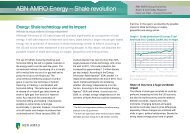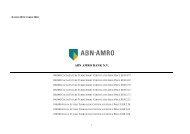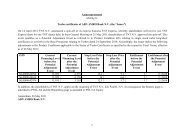ABN AMRO TURBOS - ABN AMRO Markets
ABN AMRO TURBOS - ABN AMRO Markets
ABN AMRO TURBOS - ABN AMRO Markets
Create successful ePaper yourself
Turn your PDF publications into a flip-book with our unique Google optimized e-Paper software.
Leverage effect.<br />
The leverage effect causes the value of a Turbo to fluctuate at a faster rate than the value of<br />
the underlying. This is an important characteristic of Turbos. The leverage rate indicates how<br />
much faster this movement takes place. The higher the leverage rate, the greater the change in<br />
response to a movement in the underlying. For example, should an investor acquire a Turbo Long<br />
with a ratio of 1 and a leverage rate of 5, the value of that Turbo will change by 5% for every 1%<br />
movement in the value of the underlying. This implies that an increase of 3% in the value of the<br />
underlying will result in a 15% increase in the value of the Turbo Long. However, the leverage<br />
effect works both ways: a decrease of 3% in the value of the underlying will result in a 15%<br />
decrease in the value of the Turbo Long. For a Turbo Short, the leverage effect works inversely.<br />
A Turbo Short with a ratio of 1 and a leverage rate of 5 will increase by 5% for every 1% decrease<br />
in the value of the underlying. As such, a decrease of 3% in the value of the underlying will result<br />
in a 15% increase in the value of the Turbo Short, whereas a 3% increase in the value of the<br />
underlying will result in a 15% decrease in the value of the Turbo Short.<br />
Each Turbo has its own leverage rate. The leverage rate depends on the price of the underlying<br />
at the time of purchase (reference price) and on the financing level of the Turbo:<br />
Result<br />
60%<br />
40%<br />
20%<br />
0%<br />
-20%<br />
-40%<br />
-60%<br />
Turbo Long Leverage 10<br />
Turbo Long Leverage 5<br />
Underlying<br />
Figure 2. Example leverage effect of two<br />
fictional Turbos Long with a leverage rate<br />
of 5 and 10 vis-à-vis the underlying.<br />
Price<br />
Leverage rate<br />
Turbo Long<br />
Leverage rate<br />
Turbo Short<br />
=<br />
=<br />
Reference price of underlying<br />
(Reference price of underlying – Financing level)<br />
Reference price of underlying<br />
(Financing level – Reference price of underlying)<br />
When a Turbo Long has a financing level of EUR 10 and the reference price of an underlying is<br />
listed at EUR 15, the leverage rate of the Turbo Long will be equal to 3 [EUR 15 / (EUR 15 – EUR<br />
10)].<br />
Because the reference price of an underlying changes continuously, the leverage rate of a<br />
Turbo can only be set when it is acquired. Once the Turbo has been acquired, the leverage<br />
rate will remain constant for the investment period, assuming a constant financing level.<br />
€5<br />
€10<br />
Leverage= 3<br />
Underlying = 15<br />
€8<br />
€10<br />
Value<br />
Turbo +60%<br />
Underlying +20%<br />
The value of a Turbo Long with a financing level of EUR 10 and an underlying value of<br />
EUR 15 is equal to EUR 5. The leverage rate for this Turbo Long is equal to 3. Should the value<br />
of the underlying increase by 20% to EUR 18, the value of the Turbo Long will simultaneously<br />
increase by 60% to EUR 8 (EUR 18 – EUR 10). This is equal to a threefold increase in the<br />
value of the underlying. Please note, that the reference price of the underlying remains<br />
EUR 15. As such, the leverage rate of the Turbo will remain 3 and will not change if the value<br />
of the underlying increases.<br />
Value Turbo<br />
Financing level<br />
Figure 3. Example leverage effect of a<br />
fictional Turbo Long with a leverage<br />
rate of 3.<br />
4






